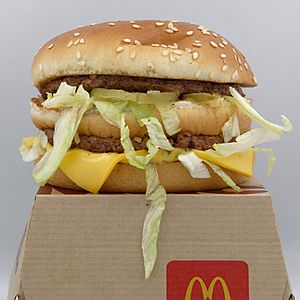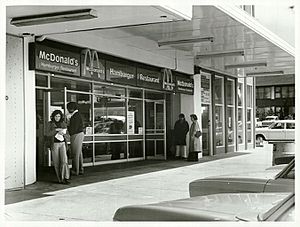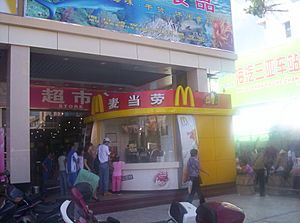History of McDonald's facts for kids
McDonald's is a super famous fast-food restaurant chain. It started way back in 1940 and has grown to be the biggest restaurant chain in the world when you look at how much money it makes. People all over the globe love its burgers, fries, and shakes!
Contents
How McDonald's Began
The McDonald Brothers' Idea
In the late 1930s, two brothers, Richard and Maurice McDonald (people called them Dick and Mac), moved to Hollywood, California. Their dad, Patrick McDonald, opened a small food stand called The Airdrome in 1937. It was near an airport in Monrovia, California.
By 1948, the brothers noticed that most of their money came from selling hamburgers. So, they closed their busy drive-in restaurant. They wanted to make things simpler and faster. Their new menu had only hamburgers, cheeseburgers, potato chips, coffee, soft drinks, and apple pie.
In 1952, the brothers decided they needed a brand new building. They wanted it to be even more efficient and look super cool. They hired an architect named Stanley Clark Meston. The brothers and Meston worked closely together. They even drew the exact size of every kitchen machine with chalk on a tennis court! This helped them plan the perfect layout.
The Famous Golden Arches
The new building looked amazing with its shiny red and white tiles, stainless steel, and bright neon lights. It also had two giant, yellow sheet-metal arches that were 25 feet tall. They called these the "Golden Arches". A smaller sign by the road showed a character named Speedee, a chubby chef striding across the top. The brothers also designed the restaurant to encourage people to eat quickly. For example, the seats were fixed and angled, and the cups were cone-shaped, so you had to hold them.
In late 1953, the brothers started looking for people to open new McDonald's restaurants. Their first partner was Neil Fox, who opened a McDonald's in Phoenix, Arizona, in May 1953. This was the first one with the Golden Arches design. The second one opened in Downey, California, in August 1953. This Downey restaurant is the oldest McDonald's still open today.

Ray Kroc Joins the Team
In 1954, a salesman named Ray Kroc found out that the McDonald brothers were using eight of his milkshake machines. He was curious and visited their restaurant in San Bernardino. Kroc was amazed by how fast and efficient their system was.
Kroc believed the McDonald's idea could be a huge hit across the United States. He suggested that the brothers let him help them open more restaurants. The brothers were not sure at first. They thought their self-service idea might not work in colder places. But Kroc offered to take on the main job of setting up new McDonald's places everywhere else. He got the rights to open McDonald's restaurants across the country. The brothers would get a small percentage of the sales.
McDonald's Buys Its Land
In 1956, Ray Kroc met Harry J. Sonneborn. Harry had a clever idea to help McDonald's grow even faster. He suggested that McDonald's should own the land where future restaurants would be built. Kroc liked this idea and hired Harry. They created a special company called Franchise Realty Corp to buy and own the land. This meant McDonald's could lease the land to the people who wanted to open a franchise. This smart move helped McDonald's become very strong financially. Even today, McDonald's owns a lot of land, which is a big part of its value.
Growth in the 1960s and 1970s

By 1960, McDonald's restaurants were making $56 million every year! More cars on the road and new highways helped McDonald's become even more popular. In 1961, Ray Kroc wanted to buy out the McDonald brothers completely. He asked them how much they wanted for their share of the business. They asked for $2.7 million. Kroc didn't have that much money, but Harry Sonneborn helped him get it. Kroc then bought the brothers' part of the company. This helped McDonald's become the top fast-food chain in the country.
Ray Kroc and Harry Sonneborn later disagreed about how fast the company should grow. Harry Sonneborn left in 1967, and Kroc became the main boss.
McDonald's became very successful in the 1960s because it was good at marketing and listened to what customers wanted. In 1962, they introduced the Filet-O-Fish sandwich. In 1967, a restaurant owner named Jim Delligatti created the Big Mac. It was added to McDonald's national menu the next year.

Some people doubted if McDonald's could grow much outside the U.S. In 1974, two brothers, Wally and Hugh Morris, wanted to bring McDonald's to New Zealand. Ray Kroc wasn't keen on the idea at first. But the Morris brothers finally got a franchise in May 1975. They even made a deal to sell New Zealand cheese to the U.S. to help with the costs. The first New Zealand McDonald's opened in June 1976 in Porirua. It was much more successful than expected!
McDonald's from the 1980s to Today
The first McDonald's Express locations opened in 1991. These are smaller restaurants, often in city storefronts. They might not have all the menu items, like milkshakes or Quarter Pounders.
The first McDonald's in Mainland China opened in October 1990.
The Extra Value Meal, which is a burger, fries, and a drink all together, started in 1993. In 2000, a McDonald's in Dearborn, Michigan, was the first east of the Mississippi River to offer halal food for Muslim customers. In January 2012, the company announced that it made a record $27 billion in 2011. They also planned to update 2,400 restaurants and open 1,300 new ones around the world.
In the mid-2010s, McDonald's started having lower profits. To fix this, they began offering some of their breakfast menu items all day long starting in 2015. At first, some restaurant owners were not happy. They said it made service slower. But the plan worked out well. The company's earnings went up, beating what experts had predicted.



